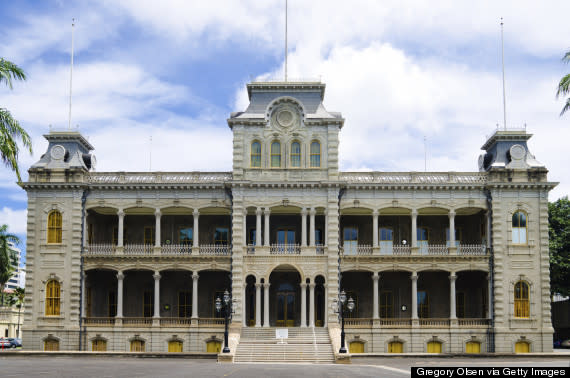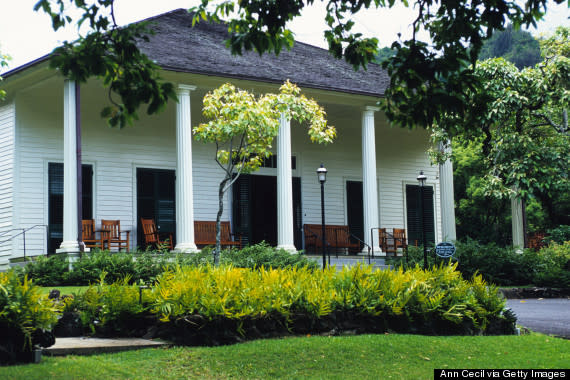This Is How You Have A Royal Vacation In Hawaii
Alright, we get it Lorde --we'll never be royals(rooooyals).It don't run in our blood.
But that won't stop us from pretending every now and again. And what better place for a game of monarchical make-believe than the 50th state. After all, Hawaii used to be a monarchy, and the remnants of royalty are visible all over the islands.
Next time you find yourself in the Aloha state, follow in the footsteps of Hawaiianali'i (royalty)and seek out these historic locales. Trust us, you'll be impressed -- they were fit for kings.
Queen’s bath, Kauai
This isn’t the original Queen’s Bath -- the first one, located on the Big Island, wasfilled in by a lava flow in 1990-- but this tide pool, near Princeville on Kauai, is considered its successor.
Historically, only the ali'i werepermitted to bathe in the sacred waters,but (lucky for us) it's now a tourist attraction.
Use extreme caution, however, becauseit's highly dangerous.Large, rogue waves have been known to sweep swimmers out to sea with ease.

Another Day is Done by Stephen Kennedy on 500px
Iolani Palace, Oahu
Welcome to theonlyroyal palace in the United States. Pretty cool, huh? Completed in 1882, Iolani Palace washome to King Kalᅣチkaua and his wife, Queen Kapi‘olani.It also served as residence to Queen Lili‘uokalani, Hawaii's final reigning monarch.
Its opulent hallshad electricity before the White House(eat your heart out, Grover Cleveland), and the home is still regularly used for events and is open for tours. If you find yourself in downtown Honolulu on a Friday afternoon, you can even catch one of thefree concertsfrom the Royal Hawaiian Band.

Kaniakapupu ruins, Oahu
Want to party like a king? This was basically King Kamehameha III's party pad. The decaying ruins aren't as old as you might think. The structure was built in 1845, but Hawaii's harsh conditions -- humidity, rain, wind and salty air -- have taken an obvious toll.
Kaniakapupu was a 40-by-45 foot house that is said to havebeen the site of a massive luaufor more than 10,000 people in 1847.
Kaniakapupu is easy to access; a ten minute hike from Old Pali Road takes you right to it.

Kaniakapupu I by shauntokunaga on 500px
Iao Valley, Maui
We know you recognize this place because "Turbo: A Power Rangers Movie" was partially filmed there, but Iao Valley's history dates back even further than 1997.
What used to be closed off to mere commoners like us is now a designated U.S. National Natural Landmark, and many native plants thrive in the valley. In fact, back in the day, valleys on the islands provided natural land divisions called ahupua‘a, but Iao Valley wastoosacred for any of that. A volcanic formation known as the Iao Needle (pictured below, on the left) is said to represent Kanaloa, the Hawaiiangod of the oceans, and various ali‘i are said to be buried in Iao in secret places.

Queen Emma’s Summer Palace:
It's funny to think that people in Hawaii have "summer" homes, but Queen Emma's summer home, also known as Hanaiakamalama, provided a cool, verdant retreat from the hustle and bustle of Honolulu. Nestled into the lush Nuuanu valley, it wasbuilt sometime in the 1840s.
Queen Emma Kalanikaumakaᅧᄏamano Kaleleonᅣチlani Naᅧᄏea Rooke, wife to King Kamehameha IV, used Hanaiakamalama as a summer escape until her death in 1885.
We want to go ona tourjust to hear these names pronounced, but we'll stay for the hula and ukulele classes.

Pali Lookout, Oahu
This breathtaking lookoutplayed a crucial role in the 1795 Battle of Nuuanu,the climactic battle in Kamehameha I's quest to unify the Hawaiian Islands. It is said that more than 400 warriors fell to their deaths after being pushed over the 1,000-foot cliff by Kamehameha's advancing forces.
Today, the vantage point offers a sweeping view that stretches from the northern shores to the famed Kailua and Lanikai beaches -- pretty much most of the windward side.

Nu‘uanu Pali by Earl Dieta on 500px
Bishop Museum
You wouldn't normally think to go to a museum when visiting Hawaii (that's what Europe is for, right?), but the Bishop Museum is definitely worth a look. Consider it a one stop shop for all things Hawaiian history, arts, science and culture.
Founded in 1889, the museum was built tohouse the Hawaiian artifactsowned by Princess Bernice Pauahi Bishop, the last descendant of the Kamehameha family, and is now home to everything from demonstrations of volcanic eruptions to extinct animal specimens.

Inside Bishop Museum by Panot K on 500px
Waipio Valley, Big Island
This lush valley, known today as the Valley of the Kings, stretches six miles long on the north side of Hawaii island and was the capital and permanent residence of many early Hawaiian aliᅧᄏi. Not too many people live there today, and those who do are mostly native Hawaiians who tend to the sacred lands. The Frommer's guide to the Big Island recommendsgoing with a guided tour, obeying the "keep out" signs, and watching out for any dogs, stray or otherwise.
In 1994, somebody stole the iwi (Hawaiian bones) ofdeified 15th- or 16th-century chiefs Liloa and Lonoikamakahikifrom the Bishop Museum on Oahu andmay have placed themsomewhere in Waipi‘o.

This article originally appeared on HuffPost.

